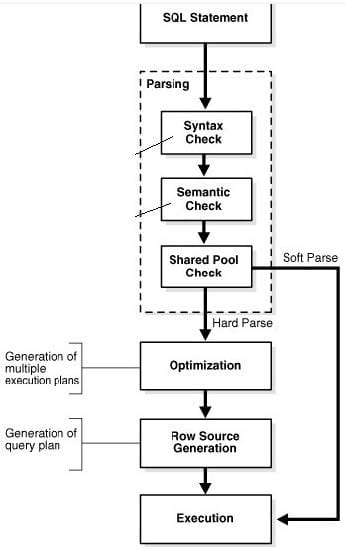Exam Details
Exam Code
:1Z0-117Exam Name
:Oracle Database 11g Release 2: SQL Tuning ExamCertification
:Oracle CertificationsVendor
:OracleTotal Questions
:125 Q&AsLast Updated
:Jun 29, 2025
Oracle Oracle Certifications 1Z0-117 Questions & Answers
-
Question 61:
Exhibit
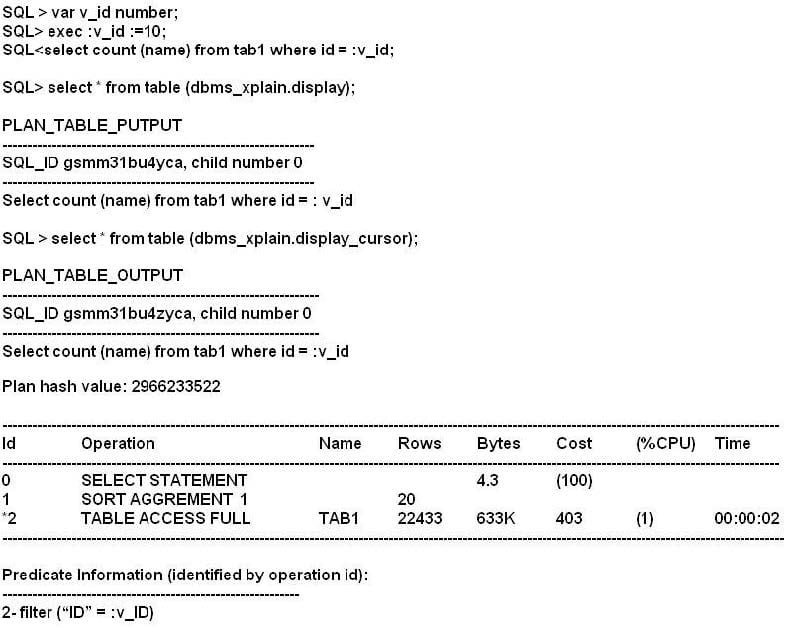
A table has three distinct values in its ID column. In the ID column, values 10 and 20 have more than 20000 rows each and value 30 has only five rows. The
statistics for the schema have been updated recently.
The CURSOR_SHARING parameter is set to EXACT.
The query was executed recently and the cursor for the query is bind aware. Examine the exhibits to view the commands executed.
You plan to execute the same query with a value of 30 for the bind variable V_ID.
Which statement is true in this scenario?
A. The same execution plan will always be used irrespective of the value in the bind variable.
B. A new execution plan will be generated depending on the access pattern and the bind value.
C. Adaptive cursor sharing will ensure that a new cursor is generated for each distinct value in the bind variable.
D. Adaptive cursor sharing will happen only if you use the literal values instead of bind variables in the query.
-
Question 62:
Which three options are true about parallel queries when PARALLEL_DEGREE_POLICY is set to MANUAL and the session is using the default settings for parallel query, DDL, and DML?
A. A subquery in a parallel DML is parallelized only if it includes a parallel hint.
B. The number of parallel execution servers requested for a cursor is based on the greatest degree of parallelism associated with any object accessed by the cursor.
C. A SELECT statement can be executed in parallel only if no scalar subqueries are contained in the SELECT list.
D. In a CREATE TABLE . . . AS SELECT (CTAS) statement, SELECT is parallelized only if create TABLE is parallelized.
E. In an INSERT INTO . . . SELECT FROM statement, INSERT is parallelized if select is parallelized.
F. Single row inserts are never executed is parallel.
-
Question 63:
You execute the following query for the first time:

Examine the SQL statement processing steps:
1.
The value of the variable SAL is obtained to run the query.
2.
The syntax of the query is checked
3.
A parse tree for the query is generated
4.
Semantics for the query are checked
5.
The required rows are fetched
6.
The SQL is executed to produce the required result.
Which is the correct order of execution of the above query?
A. 1, 2 3, 4, 5, 6
B. 1, 4, 2, 3, 6, 5
C. 2, 4, 1, 3, 6, 5
D. 2, 3, 1, 4, 6, 5
-
Question 64:
You plan to bulk load data using INSERT /*+PARALLEL*/ INTO . . . . SELECT FROM statements.
Which four types of operations can execute in parallel on tables that have no bitmapped indexes or materialized views defined on term?
A. Direct path insert of a million rows into a partitioned, index-organized table containing one million rows.
B. Direct path insert of a million rows into a partitioned, index-organized table containing 10 million rows.
C. Direct path insert of a million rows into a nonpartitioned, index-organized table containing one million rows.
D. Direct path insert of a million rows into a nonpartitioned, heap-organized table containing 10 million rows.
E. Direct path insert of a million rows into a nonpartitioned, heap-organized table containing one million rows.
-
Question 65:
Examine the statements being executed for the first time:

Steps followed by a SQL statement during parsing:
1.
Search for a similar statement in the shared pool.
2.
Search for an identical statement in the shared pool.
3.
Search the SQL area of identical statement already in the shared pool.
4.
Proceed through the remaining steps of the parse phase to ensure that the execution plan of the existing statements is applicable to the view statement.
5.
Perform hard parsing.
6.
Share the SQL area of the similar statement already in the shared pool.
Identify the required steps in the correct sequence used by the third query.
A. 5, 1, 3, 4
B. 2, 4, 3
C. 5, 2, 3, 4
D. 1, 4, 3
E. Only 5
F. 2, 5
-
Question 66:
A database instance is configured in the shared server mode and it supports multiple applications running on a middle tier. These applications connect to the
database by using different services and tracing is enabled for the services. You want to view the detailed tracing setting for particular service.
What would you use to view the tracing information?
A. DBMS_SERVICE package
B. DBMS_MONITOR package
C. DBA_ENABLED_TRACES view
D. Trcsess and tkprof
-
Question 67:
Examine the parallel parameters for your instance.
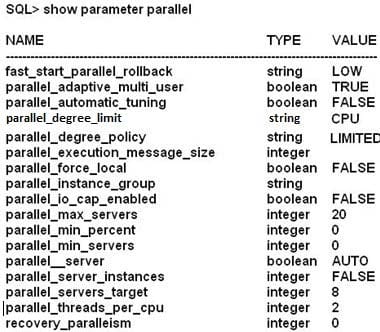
All parallel execution servers are available and the session use default parallelism settings. In which two cases will the degree of parallelism be automatically calculated?
A. Statements accessing tables whom dictionary DOP is 2 or more
B. Statements accessing tables whose dictionary DOP is DEFAULT
C. Statements that are estimated to execute for more than 10 seconds serially
D. Statements accessing tables with any setting for Dictionary DOP
E. Statements with parallel hints
-
Question 68:
Examine the Exhibit and view the structure of an indexes for the EMPLOYEES table.
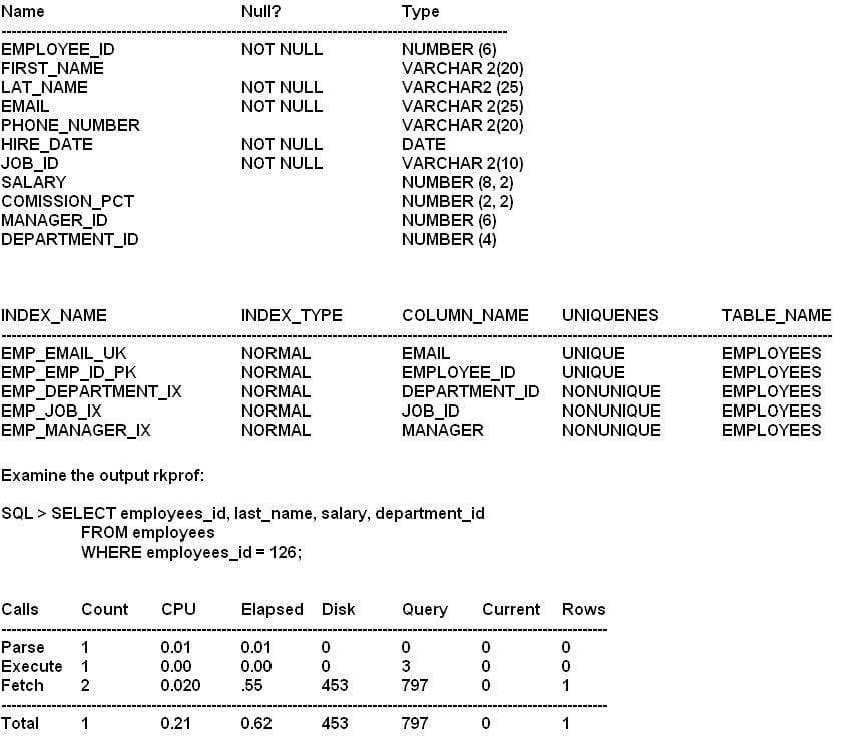
Which two actions might improve the performance of the query?
A. Use the ALL_ROWS hint in the query.
B. Collect the histogram statistics for the EMPLOYEE_ID column.
C. Decrease the value for the DB_FILE_MULTIBLOCK_READ_COUNT initialization parameter.
D. Decrease the index on the EMPLOYEE_ID if not being used.
E. Set the OPTIMIZER_MODE parameter to ALL_ROWS.
-
Question 69:
How can you reduce fragmentation of an index without affecting the current transactions that are using the index?
A. Use the ANALYZE INDEX . . . command
B. Use the ALTER INDEX . . . VALIDATE STRUCTURE command
C. Us the ALTER INDEX . . . REBUILD ONLINE command
D. Use the ALTER INDEX . . . DEALLOCATE UNUSED command
-
Question 70:
Examine the Following Query and execution plan:
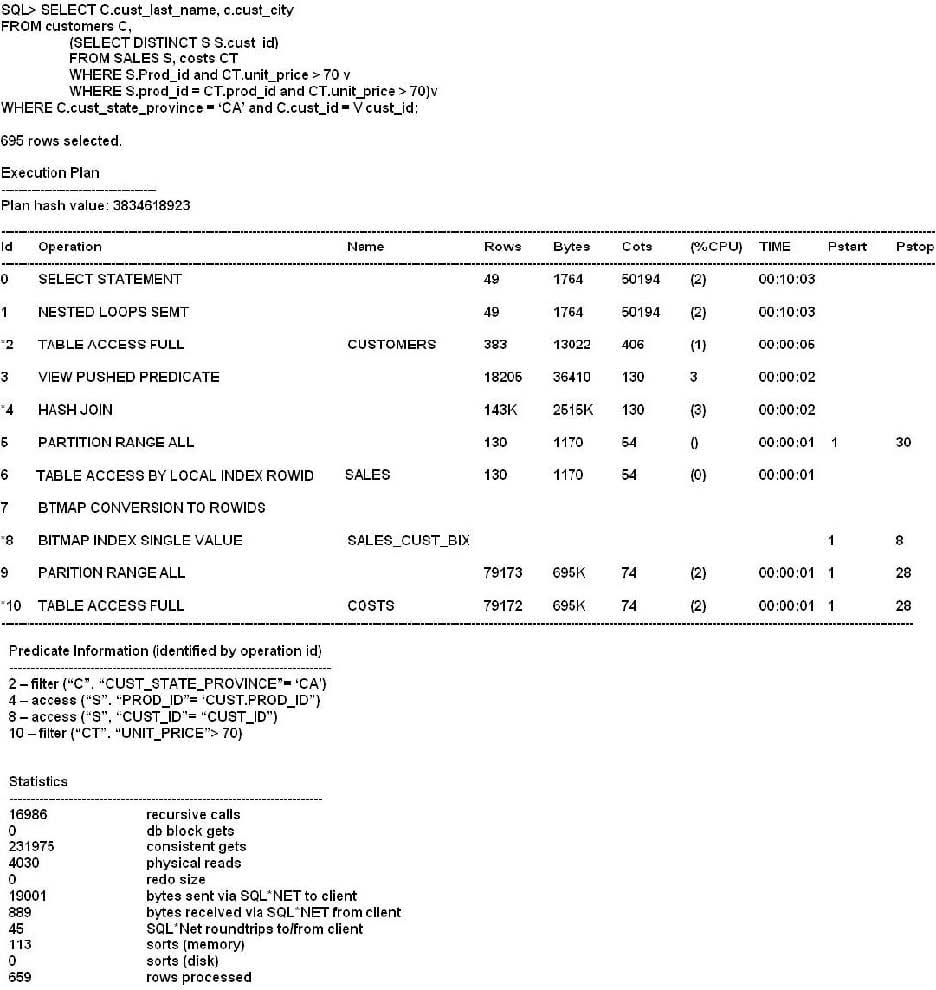
Which query transformation technique is used by the optimizer?
A. Filter push down
B. Subquery factoring
C. Subquery unnesting
D. Predicate pushing
Related Exams:
1Z0-020
Oracle8i: New Features for Administrators1Z0-023
Architecture and Administration1Z0-024
Performance Tuning1Z0-025
Backup and Recovery1Z0-026
Network Administration1Z0-034
Upgrade Oracle9i/10g OCA to Oracle Database OCP1Z0-036
Managing Oracle9i on Linux1Z0-041
Oracle Database 10g: DBA Assessment1Z0-052
Oracle Database 11g: Administration Workshop I1Z0-053
Oracle Database 11g: Administration II
Tips on How to Prepare for the Exams
Nowadays, the certification exams become more and more important and required by more and more enterprises when applying for a job. But how to prepare for the exam effectively? How to prepare for the exam in a short time with less efforts? How to get a ideal result and how to find the most reliable resources? Here on Vcedump.com, you will find all the answers. Vcedump.com provide not only Oracle exam questions, answers and explanations but also complete assistance on your exam preparation and certification application. If you are confused on your 1Z0-117 exam preparations and Oracle certification application, do not hesitate to visit our Vcedump.com to find your solutions here.
